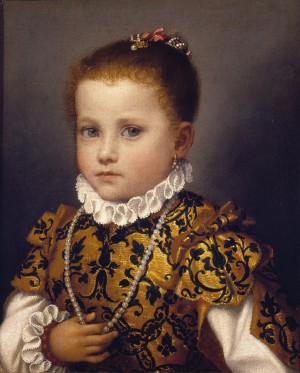A Taste of Bergamo at the Met: Bellini, Titian, and Lotto Have Come For a Visit
The ancient Greek physician Hippocrates famously remarked that life is short, but art is long and The Metropolitan Museum’s current exhibition of north Italian Paintings from the Accademia Carrara in Bergamo, while decidedly “short” (only 15 paintings), is long on beauty, color, and the inimitable style that has defined 15th and 16th century Italian art.
The Carrara’s “loss,”of these works – temporarily due to the Accademia’s closure for restoration – is the visitors’ gain, acquainting them with this loan of little known or unknown paintings by the exhibition’s titular and familiar artists such as Bellini, Titian, and Lotto, and the less famous (to laymen, at least) such as Moretto da Brescia or Andrea Previtali.
The Accademia’s collection, housed in its elegant Neoclassical building down the hill from Bergamo, is the offspring of Count Giacomo Carrara, who founded the museum at the end of the 18th century. It contains works dating from the 14th to the 19th centuries, and at its heart is a group of superb pictures from the Renaissance, such as the sampling that comprise the Met’s exhibition. These works represent Bergamo’s “golden age,” whose artists trained in the great workshops of Venice and brought back in their travel bags the techniques as well as the devotional and naturalistic manner of painting native to Lombardy.
Portraits and works of secular and religious subjects grace the walls of the sky lighted Lorre Heinemann Gallery, each in its own way offering a perfect visual taste of the skill of its creator.
Titian’s Orpheus and Eurydice, early oil on wood work (which some critics have rejected as an authentic Titian) is ambitious in its representation of a pastoral-mythological subject, and one marrying the styles of diverging artists such as Giorgione and Bosch in its choice of palette and treatment of the figures, respectively. The painting’s almost constant dark tonality and ill-defined figural depictions rank this piece low on the totem pole of this otherwise vibrant exhibition.
By contrast, Lotto’s narrative-rich St. Dominic Reviving Napoleone Orsini; The Entombment; and The Stoning of Saint Stephen, a three-predella panel work, once part of a larger altarpiece which Lotto did for the Dominican Church of SS Stefano e Domenico in Bergamo, makes the visitor linger to fully drink in the pictorial details of each story and to revel in the energetic color imparted by the artist.
Lorenzo Lotto’s oil on wood portrait of Lucina Brembati is impressive in terms of the artist’s meticulous attention to surface details – the glint of gold; the texture of diverse fabrics; the rendering of the sitter’s milky flesh – but impressive as well for the subject herself: Brembati, whose bejeweled, (don’t miss the golden toothpick hanging around her neck) substantial physical presence all but fills the confines of the painting, meets the viewer’s gaze head-on. Lotto, not above some playfulness in this otherwise serious portrait, provides the sitter’s identity by placing the letters c-i in the rebus of a crescent moon in the sky behind Brembati, these being a play on the Italian word luna, or “moon.”
Lucina is no Mona Lisa, yet Lotto has more than compensated for her limitations by injecting an admirable truthfulness to her portrait, offset by its romantically nocturnal setting.
Two other portraits, both by one of the greatest artists in this genre, Giovanni Battista Moroni, stand as exceptional high points in this show. His Portrait of a Twenty-Nine-Year-Old Man, which Roberto Longhi, a contemporary of Moroni, praised as “so real, simple, documentary, that it actually communicates a sense of certainty of having known the model,” is the artist at the zenith of his powers, having captured the young subject’s poise and forthrightness. Had Moroni wanted to, he could have given the sitter the power of speech.
Portrait of a Little Girl of the Redetti Family, a rare work in the genre, is among Moroni’s paintings creating a lasting record of Bergamo’s principal families. Tenderness and poise are conjoined in this touching and intimate portrait, where the artist’s prodigious skills are fully displayed in the young Redetti’s delicate skin and curls and her richly-brocaded dress, but most of all in her direct, gray-eyed gaze. No doubt she broke a thousand hearts within a few short years.
On a sunlit day, the soft and filtered rays from the Heinemann Gallery skylight create the proper atmospheric setting for these paintings, perhaps the next best thing after the Carrara. Not an exhaustive exhibition, it can be taken in within at least a half hour to 45 minutes, and, thankfully, a bench is provided to catch the foot-weary.
There is little to disappoint in this exhibition, the early and somewhat muddy-toned Titian, notwithstanding, although this reviewer would have enjoyed the inclusion of at least one sculpture work to counterbalance the paintings. This is a bat-squeak of a complaint, however, for the Met has once again organized a show of beauty created by some of the best brains of the Italian Renaissance.
It will hold us until we make it to Bergamo.
“Bellini, Titian, and Lotto: North Italian Paintings from the Accademia Carrara, Bergamo” is on view through September 3, 2012 at the Metropolitan Museum of Art located at 1000 Fifth Avenue, New York, New York 10028. For more information on the exhibit and museum hours visit www.metmuseum.org or call 212-535-7710.











